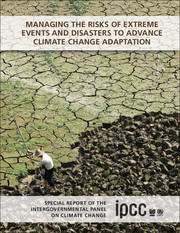 Managing the Risks of Extreme Events and Disasters to Advance Climate Change Adaptation
Managing the Risks of Extreme Events and Disasters to Advance Climate Change Adaptation from Section III
Published online by Cambridge University Press: 05 August 2012
Executive Summary
Extreme impacts can result from extreme weather and climate events, but can also occur without extreme events. This chapter examines two broad categories of impacts on human and ecological systems, both of which are influenced by changes in climate, vulnerability, and exposure: first, the chapter primarily focuses on impacts that result from extreme weather and climate events, and second, it also considers extreme impacts that are triggered by less-than-extreme weather or climate events. These two categories of impacts are examined across sectors, systems, and regions. Extreme events can have positive as well as negative impacts on ecosystems and human activities.
Economic losses from weather- and climate-related disasters have increased, but with large spatial and interannual variability (high confidence, based on high agreement, medium evidence). Global weather- and climate-related disaster losses reported over the last few decades reflect mainly monetized direct damages to assets, and are unequally distributed. Estimates of annual losses have ranged since 1980 from a few US$ billion to above 200 billion (in 2010 dollars), with the highest value for 2005 (the year of Hurricane Katrina). In the period 2000 to 2008, Asia experienced the highest number of weather- and climate-related disasters. The Americas suffered the most economic loss, accounting for the highest proportion (54.6%) of total loss, followed by Asia (27.5%) and Europe (15.9%). Africa accounted for only 0.6% of global economic losses. Loss estimates are lower bound estimates because many impacts, such as loss of human lives, cultural heritage, and ecosystem services, are difficult to value and monetize, and thus they are poorly reflected in estimates of losses. [4.5.1, 4.5.3.3, 4.5.4.1]
To save this book to your Kindle, first ensure [email protected] is added to your Approved Personal Document E-mail List under your Personal Document Settings on the Manage Your Content and Devices page of your Amazon account. Then enter the ‘name’ part of your Kindle email address below. Find out more about saving to your Kindle.
Note you can select to save to either the @free.kindle.com or @kindle.com variations. ‘@free.kindle.com’ emails are free but can only be saved to your device when it is connected to wi-fi. ‘@kindle.com’ emails can be delivered even when you are not connected to wi-fi, but note that service fees apply.
Find out more about the Kindle Personal Document Service.
To save content items to your account, please confirm that you agree to abide by our usage policies. If this is the first time you use this feature, you will be asked to authorise Cambridge Core to connect with your account. Find out more about saving content to Dropbox.
To save content items to your account, please confirm that you agree to abide by our usage policies. If this is the first time you use this feature, you will be asked to authorise Cambridge Core to connect with your account. Find out more about saving content to Google Drive.